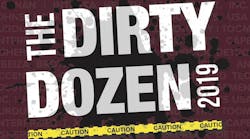By Jessica Martinez and Marcy Goldstein-Gelb
In a recent post about National COSH’s “Dirty Dozen” report on unsafe employers, editor Dave Blanchard says it’s a “head scratcher” that a company like Facebook made the list. Was the tech giant, he wonders, “chosen for its ‘name recognition’ more so than for its actual unsafe working conditions?”
Our method for selecting the Dirty Dozen is consistent with our approach to advocating for safer workplaces. We listen to workers and confirm what they have to say with trustworthy sources of information.
We named Facebook, as well as its contracting partners Accenture, Cognizant, ProUnlimited and Tech Solutions, because of multiple, credible reports about hazards faced by workers who spend hours each day moderating offensive content, including beheadings, child pornography and other disturbing images.
“I don’t think it’s possible to do the job,” said one former moderator “and not come out of it with some acute stress disorder or PTSD.”
Mental health illnesses are real and widespread and cannot be effectively addressed by OSH professionals if they are minimized or stigmatized. It’s true, as EHS Today points out, that such illnesses—and many other workplace injuries—may not “meet the threshold of OSHA violations.” That doesn’t mean they are not serious safety issues deserving attention and remediation.
OSHA standards, inspections and enforcement are a useful tool for workers and employers who seek to make workplaces as safe as possible. But action by OSHA or state safety agencies is not the only tool available. For various reasons—including lack of resources, the use of third-party contracting, the slow process of creating new safety standards, and under-reporting due to a justifiable fear of employer retaliation—most severe, preventable workplace hazards may never come to the attention of government regulators. Highlighting on-the-job dangers that might otherwise be ignored is one of the reasons we publish the Dirty Dozen report in the first place.
Mr. Blanchard is also curious about why XPO Logistics is on this year’s list, since the company “has also been named to various ‘best employers’ and ‘best places to work’ lists.” We’re not familiar with the criteria used for these rankings. We do know, as documented by a New York Times investigation, that six workers at an XPO facility in Memphis, TN, suffered miscarriages after hours of heavy lifting on the job with little or no accommodations for their pregnancies.
Four workers also told the Times that after a co-worker collapsed and died at the warehouse from a cardiac arrest, “[m]anagers told workers to keep moving boxes as her body lay on the floor.” In our view, the loss of six pregnancies and callous behavior after the loss of a worker’s life signal a dangerous workplace, regardless of any other recognition XPO might have received.
Prior to the closing of the warehouse, XPO workers had been addressing safety problems by attempting to organize a union. Mr. Blanchard suspects that’s the real reason XPO is on the Dirty Dozen and suggests that the real title of our report should be “Big-Name Organizations that Have Resisted Union-Organizing Efforts and Have Some Workplace Safety Issues.” Aside from being a bit long, that title just doesn’t fit. There is no organizing activity we are aware of at eight of the twelve companies on this year’s Dirty Dozen. (They’re not all big names, either.)
The headline of EHS Today’s post asks: “Do Unions Make Workplaces Safer?” but the question is never answered in the body of the piece. We do answer it in our report, citing a study by Prof. Alison Morantz of Stanford University who finds that in the mining industry, “unionization predicts a substantial and significant decline in traumatic injuries and fatalities.” We also cite a paper by research scientist Roland Zullo from the University of Michigan, who finds “higher levels of unionization equate with lower fatality rates” in the construction industry.
Whatever your perspective on unionization, we hope all can agree that workplace safety is about much more than statistics or awards or lists. It’s about women and men and their families. In 2017, we named Fuyao Glass in Dayton, Ohio, as a Dirty Dozen company. The firm was nominated by workers who were in the process of a union organizing drive—the precise scenario which invites skepticism from EHS Today.
Fuyao was cited by OSHA in 2017 for repeat and serious safety violations, failing to provide workers with safety equipment and exposing them to risks of laceration and amputation. In 2018, a forklift operator named Ricky Paterson was crushed to death by a ton of glass at the same Fuyao facility. If the company had remedied the safety issues first raised by workers, then investigated by OSHA, and finally highlighted in our report, Mr. Paterson might be alive today.
We stand by our Dirty Dozen report, and we stand by our methods. Direct worker testimony about actual working conditions is the most important source of reliable information for the professional safety and health community. Taking these concerns seriously will save lives.
Jessica Martinez and Marcy Goldstein-Gelb are co-executive directors of the National Council for Occupational Safety and Health (National COSH), an organization dedicated to promoting safe and healthy working conditions for all working people through organizing and advocacy.
